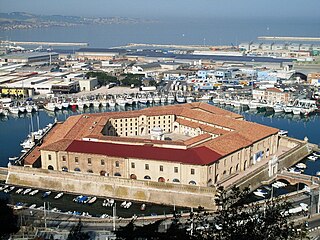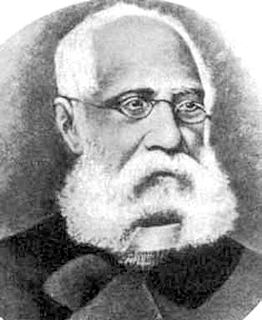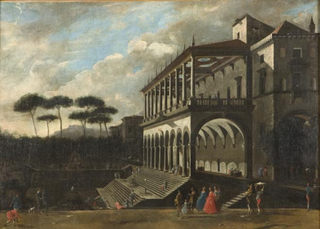
San Miniato al Monte is a basilica in Florence, central Italy, standing atop one of the highest points in the city. It has been described as one of the finest Romanesque structures in Tuscany and one of the most scenic churches in Italy. There is an adjoining Olivetan monastery, seen to the right of the basilica when ascending the stairs.

The Cimitero Monumentale[tʃimiˈtɛːro monumenˈtaːle] is one of the two largest cemeteries in Milan, Italy, the other one being the Cimitero Maggiore. It is noted for the abundance of artistic tombs and monuments.

The Astronomical Observatory of Capodimonte is the Neapolitan department of Istituto Nazionale di Astrofisica, the most important Italian institution promoting, developing and conducting scientific research in the fields of astronomy, astrophysics, and space science.

Ferdinando Fuga was an Italian architect who was born in Florence, and is known for his work in Rome and Naples. Much of his early work was in Rome, notably, the Palazzo della Consulta (1732–7) at the Quirinal, the Palazzo Corsini (1736–54), the façade of the Santa Maria Maggiore (1741–3), and the Church of Sant'Apollinare (1742–8). He later moved to Naples and notably designed the Albergo de'Poveri (1751–81), the façade of the Church of the Gerolamini, and that of the Palazzo Giordano.

Piazza Dante is a large public square in Naples, Italy, named after the poet Dante Alighieri. The square is dominated by a 19th-century statue of the poet Dante, sculpted by Tito Angelini.

Giovanni da Nola (1478–1559), also known as Giovanni Merliano, was an Italian sculptor and architect of the Renaissance, active in Naples.

Christianity and religion in general has always been an important part of the social and cultural life of Naples. It is the seat of the Archdiocese of Naples, and the Catholic faith is highly important to the people of Naples and there are hundreds of historic churches in the city. The Cathedral of Naples is the most important place of worship in the city, each year on September 19 it hosts the Miracle of Saint Januarius, the city's patron saint. In the miracle which thousands of Neapolitans flock to witness, the dried blood of Januarius is said to turn to liquid when brought close to relics said to be of his body: this is one of the most important traditions for Neapolitans.
The Cemetery of the 366 Fossae or Cimitero di Santa Maria del Popolo or Cimitero dei Tredici was built in 1762 a short distance from the then-dilapidated Villa Poggio Reale, and is located on a terrace of a hill overlooking the Poggioreale neighborhood of Naples, Italy. It is near the monumental Cemetery of Poggioreale, which was built on top of the ruined villa. The architect was the Florentine Ferdinando Fuga.
Tito Angelini (1806–1878) was an Italian sculptor and leader of the Academy of Fine Arts in Naples, where he was born and died.

The Lazzaretto of Ancona, also called the Mole Vanvitelliana, is a pentagonal 18th-century building built on an artificial island as a quarantine station for the port town of Ancona, Italy.

Ferdinando Petruccelli della Gattina was an Italian journalist, patriot and politician.

The Poggio Reale villa or Villa Poggio Reale was an Italian Renaissance villa commissioned in 1487 by Alfonso II of Naples as a royal summer residence. The Italian phrase "poggio reale" translates to "royal hill" in English. The villa was designed and built by Giuliano da Maiano and located in the city of Naples, in the district now known as Poggioreale, between the present Via del Campo, Via Santa Maria del Pianto and the new and old Via Poggioreale. At the time it was built, a period when the capital city of the Kingdom of Naples was renowned for elegant homes with expansive vistas of the surrounding landscape and Mount Vesuvius, the villa was outside the city walls of Naples and was one of the most important architectural achievements of the Neapolitan Renaissance. Imitated, admired, robbed of its treasures by another king, left in ruins and partially destroyed, the summer palace of the King of Naples lives on in name as a style.
Gennaro Calì was an Italian sculptor.

The siege of Naples was a siege of the Italian city of Naples in 1528 during the War of the League of Cognac.

Giovanni Scanzi was an Italian sculptor. His early apprenticeship led to formal studies in Rome, followed by a career as a prolific artist and teacher. He was particularly active creating monuments for the Monumental Cemetery of Staglieno in Genoa, with many other works located in museums, churches and public venues in Genoa and elsewhere.

Ernesto Capocci Belmonte was an Italian mathematician, astronomer and politician.













